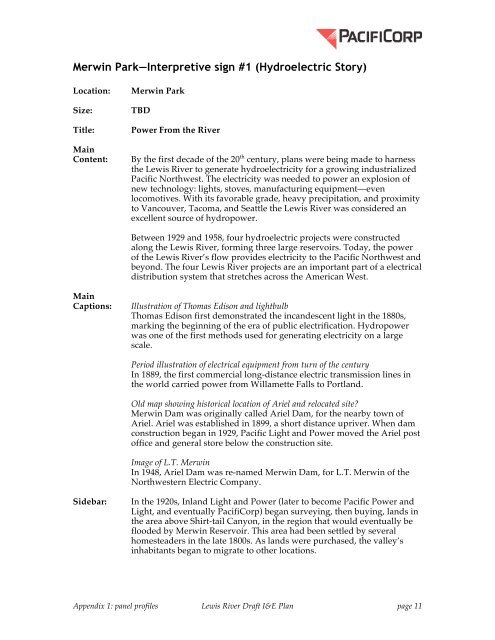The Lewis River Hydroelectric Projects - PacifiCorp
The Lewis River Hydroelectric Projects - PacifiCorp
The Lewis River Hydroelectric Projects - PacifiCorp
Create successful ePaper yourself
Turn your PDF publications into a flip-book with our unique Google optimized e-Paper software.
Merwin Park—Interpretive sign #1 (<strong>Hydroelectric</strong> Story)<br />
Location:<br />
Size:<br />
Title:<br />
Main<br />
Content:<br />
Merwin Park<br />
TBD<br />
Power From the <strong>River</strong><br />
By the first decade of the 20 th century, plans were being made to harness<br />
the <strong>Lewis</strong> <strong>River</strong> to generate hydroelectricity for a growing industrialized<br />
Pacific Northwest. <strong>The</strong> electricity was needed to power an explosion of<br />
new technology: lights, stoves, manufacturing equipment—even<br />
locomotives. With its favorable grade, heavy precipitation, and proximity<br />
to Vancouver, Tacoma, and Seattle the <strong>Lewis</strong> <strong>River</strong> was considered an<br />
excellent source of hydropower.<br />
Between 1929 and 1958, four hydroelectric projects were constructed<br />
along the <strong>Lewis</strong> <strong>River</strong>, forming three large reservoirs. Today, the power<br />
of the <strong>Lewis</strong> <strong>River</strong>’s flow provides electricity to the Pacific Northwest and<br />
beyond. <strong>The</strong> four <strong>Lewis</strong> <strong>River</strong> projects are an important part of a electrical<br />
distribution system that stretches across the American West.<br />
Main<br />
Captions:<br />
Illustration of Thomas Edison and lightbulb<br />
Thomas Edison first demonstrated the incandescent light in the 1880s,<br />
marking the beginning of the era of public electrification. Hydropower<br />
was one of the first methods used for generating electricity on a large<br />
scale.<br />
Period illustration of electrical equipment from turn of the century<br />
In 1889, the first commercial long-distance electric transmission lines in<br />
the world carried power from Willamette Falls to Portland.<br />
Old map showing historical location of Ariel and relocated site<br />
Merwin Dam was originally called Ariel Dam, for the nearby town of<br />
Ariel. Ariel was established in 1899, a short distance upriver. When dam<br />
construction began in 1929, Pacific Light and Power moved the Ariel post<br />
office and general store below the construction site.<br />
Image of L.T. Merwin<br />
In 1948, Ariel Dam was re-named Merwin Dam, for L.T. Merwin of the<br />
Northwestern Electric Company.<br />
Sidebar:<br />
In the 1920s, Inland Light and Power (later to become Pacific Power and<br />
Light, and eventually <strong>PacifiCorp</strong>) began surveying, then buying, lands in<br />
the area above Shirt-tail Canyon, in the region that would eventually be<br />
flooded by Merwin Reservoir. This area had been settled by several<br />
homesteaders in the late 1800s. As lands were purchased, the valley’s<br />
inhabitants began to migrate to other locations.<br />
Appendix 1: panel profiles <strong>Lewis</strong> <strong>River</strong> Draft I&E Plan page 11
















